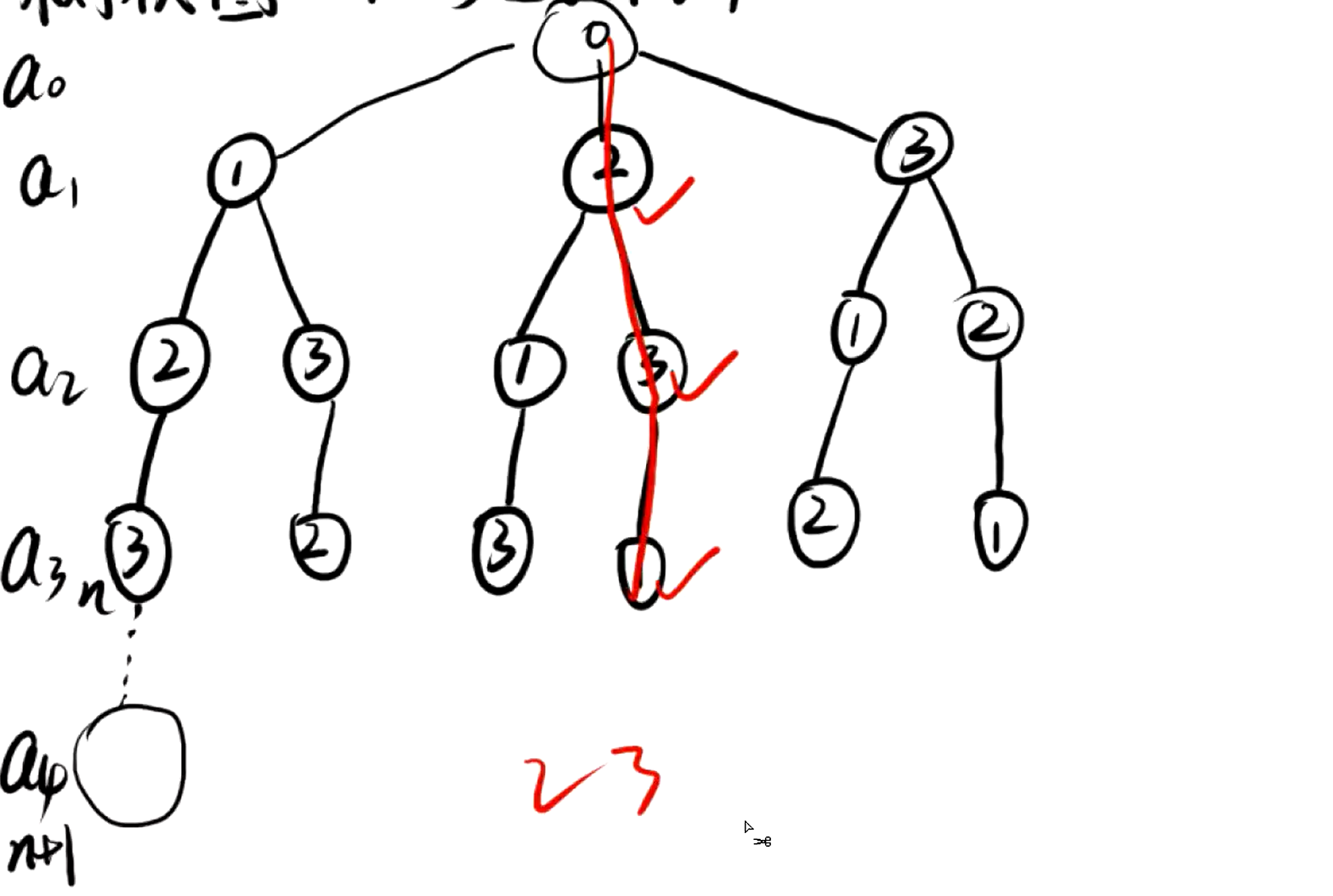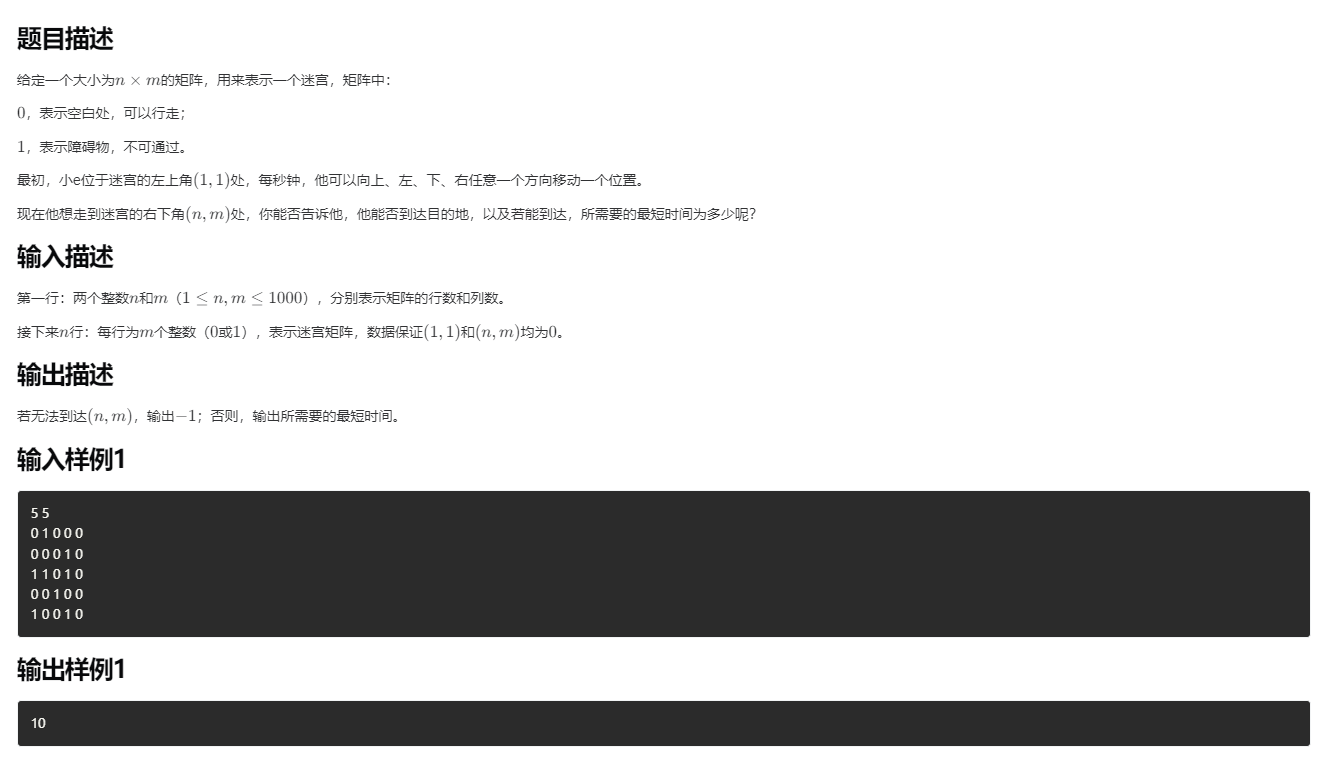图论入门
图论的存储
我们采用一种类似邻接表的形式进行存储,一个数组进行输入和存储原始数据,另一个可以开一个可变长的vector用于保存我们这个点可以通向哪个点。
int fa[1100];
vector<int> a[1100];树的遍历(DFS,BFS)
很基本直接平推即可,由于不存在环的问题,所以很简单。
题目描述
给定一棵大小为n,根为1的树,求出其dfs序、bfs序。
请将所有出点按照编号从小到大排序后进行遍历。
解释:dfs为深度优先搜索,bfs为宽度优先搜索。输入格式个整数n,表示点的个数。(1≤n≤50)
接下来一行n-1个整数,第i个数字fa表示点i的父亲。
(1<fa≤n)输出格式第一行输出dfs序,第二行输出bfs序。
样例输入1
4
112
样例输出1
1243
1234
样例输入2
5
1224
样例输出2
12345
12345
#include<bits/stdc++.h>
using namespace std;
const int N = 1100;
int fa[1100];
vector<int> a[1100];
void dfs(int x){
cout<<x<<' ';
for(auto &y : a[x])dfs(y);
}
void bfs(int x) {
queue<int> q;
q.push(x);
while(!q.empty()){
int t = q.front();
cout<<t<<' ';
q.pop();
for (auto &y : a[t]) {
q.push(y);
}
}
}
int main(){
int n;
cin>>n;
// 读入father数组
for(int i = 2;i <= n;i++)cin>>fa[i];
// 读入每个节点的子节点,并将其存入对应的数组中
for(int i = 2;i<=n;i++) a[fa[i]].push_back(i);
// 对每个节点的子节点进行排序
for(int i = 1;i<=n;i++) sort(a[i].begin(),a[i].end());
dfs(1);
cout<< endl;
bfs(1);
return 0;
}图的遍历
图中可能存在环的问题所以我们会采用一个visted数据记录我们走过的位置。

DFS解法(与之前树的DFS思路相同,只是在那个基础上加了一个visited数组)
#include<bits/stdc++.h>
using namespace std;
const int N = 1e5+10;
bitset<N> visted;
vector<int> a[N];//记得别开的太小哦
//这个地方的写法多种多样。
void dfs(int x){
visted[x] = true;
for(auto &y : a[x]){
if (visted[y])continue;
dfs(y);
}
}
int main(){
cout.tie(0),cin.tie(0),ios::sync_with_stdio(false);
int n,m;
cin>>n>>m;
for(int i = 1;i <= m; i++){
int c,b;
cin>>c>>b;
if(c!=b)
a[c].push_back(b);
}
dfs(1);
//减少时间复杂度,我们可以直接采用桶排的思想。
for (int i = 1; i <= n; ++i) {
if(visted[i]){
cout<<i<<" ";
}
}
return 0;
}BFS解法
#include<bits/stdc++.h>
using namespace std;
const int N = 1e5+10;
bitset<N> visted;
vector<int> a[N];
void bfs(int x){
queue<int> q;
q.push(x);
while (!q.empty()){
int t = q.front();
if(visted[t])return;
visted[t] = true;
q.pop();
for (auto &y : a[t]) {
bfs(y);
}
}
}
int main(){
cout.tie(0),cin.tie(0),ios::sync_with_stdio(false);
int n,m;
cin>>n>>m;
for(int i = 1;i <= m; i++){
int c,b;
cin>>c>>b;
if(c!=b)
a[c].push_back(b);
}
bfs(1);
for (int i = 1; i <= n; ++i) {
if(visted[i]){
cout<<i<<" ";
}
}
return 0;
}全排列

全排列本身就是一种树状结构可以解决的问题。我们解决算法问题归根结底就是将我们的思路清晰的写发给计算机。

我们只要一路搜索找到a4我们就会意识到我们应该返回了,所以这个地方我们要使用的应该是dfs,而因为还需要返回,所以我们还要使用一下回溯的思想,同时我们如果不进行剪枝操作的话,这的时间复杂度在n的n次方,大概到10就会超时,所以我们要进行剪枝操作。
#include<bits/stdc++.h>
using namespace std;
const int N = 1e5+10;
bitset<N> visted;
//vector<int> a[N];
int a[N];
int n;
void dfs(int depth){
//如果深度等于n+1,则输出排列,相当于我们上面图中说的终止条件
if(depth == n+1){
for (int i = 1; i <= n; ++i) {
if(i == n)cout<<a[i]<<'\n';
else cout<<a[i]<<' ';
//return;
}
}
//遍历1到n,如果已经访问过,则跳过
for(int i =1;i<=n;i++){
//利用这个条件进行剪枝操作
if(visted[i])continue;
//标记为已访问
visted[i] = true;
//将当前数字放到排列的当前位置
a[depth] = i;
//递归调用
dfs(depth+1);
//恢复现场
//回溯,即撤销刚才的访问标记
//标记为未访问
visted[i] = false;
//将当前位置的数字置为0
a[depth] = 0;
}
}
int main(){
cout.tie(0),cin.tie(0),ios::sync_with_stdio(false);
cin>>n;
dfs(1);
}
#include <bits/stdc++.h>
using namespace std;
const int N=1e3+10;
int a[N][N],n,m;
int d[N][N];
bool vis[N][N];
int dx[]={0,0,1,-1};
int dy[]={1,-1,0,0};
int mn=10000;
bool inarr(int x,int y)
{
return x>=1&&x<=n&&y>=1&&y<=m;
}
void dfs(int x,int y)
{
if(x==n&&y==m)
{
mn=min(mn,d[x][y]);
return;
}
for(int i=0;i<4;i++)
{
int nx=x+dx[i];
int ny=y+dy[i];
if(inarr(nx,ny)&&!vis[nx][ny]&&!a[nx][ny])
{
d[nx][ny]=d[x][y]+1;
vis[nx][ny]=true;
dfs(nx,ny);
vis[nx][ny]=false;
}
}
}
void bfs()
{
queue <pair<int,int> > qu;
qu.push({1,1});
vis[1][1]=true;
while(qu.size()){
int x=qu.front().first;int y=qu.front().second;
qu.pop();
for(int i=0;i<4;i++){
int nx=x+dx[i];
int ny=y+dy[i];
if(inarr(nx,ny)&&!vis[nx][ny]&&!a[nx][ny]){
d[nx][ny]=d[x][y]+1;
vis[nx][ny]=true;
qu.push({nx,ny});
}
}
}
}
int main()
{
cin>>n>>m;
for(int i=1;i<=n;i++)
for(int j=1;j<=m;j++)
cin>>a[i][j];
bfs();
if(d[n][m])
cout<<d[n][m];
else
cout<<-1;
}